Weapons
Hunting Equipment
By DANIEL WEISS
Friday, April 10, 2020
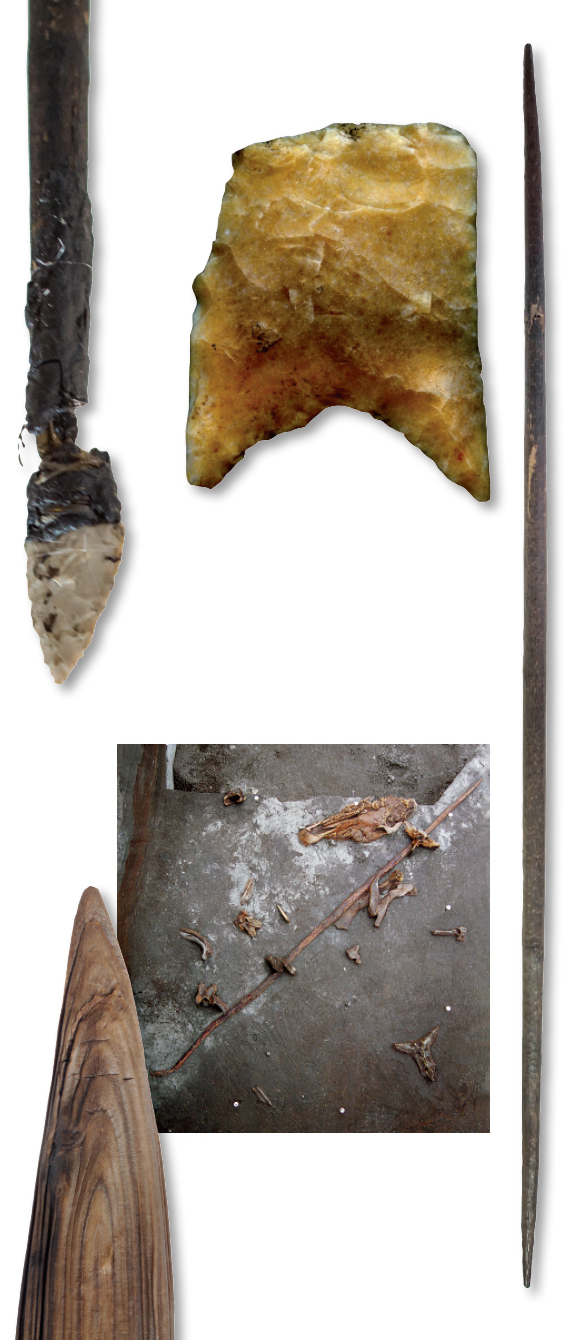 Hunting is known to be an ancient practice, but just how ancient was made clear by a discovery in a coal mine outside Schoningen, in northern Germany. There, archaeologists uncovered nine wooden spears, along with the remains of several dozen butchered horses. The spears have been dated to around 300,000 years ago, meaning they were likely used by early Neanderthals. This countered the belief of some scholars that early humans were scavengers who had not yet mastered hunting. The spears, which measure around seven feet long, were produced by experienced weapon makers who planned their hunts in advance, says archaeologist Nicholas Conard of the University of Tubingen, who oversees excavations at Schoningen. All but one spear was made from spruce trees that had grown slowly in cold conditions, producing especially hard wood. The shafts were designed to be thicker, and therefore heavier, near the front, lending them greater stability in flight, and the tips were carved slightly off-center, to avoid the soft pith at the tree trunks’ cores. “They knew exactly what they were doing,” says Conard.
Hunting is known to be an ancient practice, but just how ancient was made clear by a discovery in a coal mine outside Schoningen, in northern Germany. There, archaeologists uncovered nine wooden spears, along with the remains of several dozen butchered horses. The spears have been dated to around 300,000 years ago, meaning they were likely used by early Neanderthals. This countered the belief of some scholars that early humans were scavengers who had not yet mastered hunting. The spears, which measure around seven feet long, were produced by experienced weapon makers who planned their hunts in advance, says archaeologist Nicholas Conard of the University of Tubingen, who oversees excavations at Schoningen. All but one spear was made from spruce trees that had grown slowly in cold conditions, producing especially hard wood. The shafts were designed to be thicker, and therefore heavier, near the front, lending them greater stability in flight, and the tips were carved slightly off-center, to avoid the soft pith at the tree trunks’ cores. “They knew exactly what they were doing,” says Conard.
The Schoningen spears were likely thrown by hand, making them most effective at close range. Much later in hominin development, modern humans devised spear-throwers called atlatls that allowed them to fling projectiles at greater velocity and hunt game from farther away—likely providing an advantage over Neanderthals. A number of stone points recently discovered at the Gault site, in central Texas, were most likely hafted onto wooden shafts and hurled with atlatls at targets such as bison and mammoths, says Tom Williams of the Texas Archeological Research Laboratory at the University of Texas at Austin. The points have been dated to between 20,000 and 16,000 years ago, making them the oldest projectile points unearthed in the Americas.
Even more powerful than the atlatl is the bow and arrow, though ancient archery equipment made of perishable materials rarely survives. An exception is the bow, bowstring, quiver, and arrows found with the ice mummy Ötzi, who died high in the Italian Alps some 5,300 years ago. The 14 arrows found in Ötzi’s doeskin quiver were made from branches of the wayfaring tree. Two of these arrows were ready to be fired, a trio of feathers still stuck to their ends with birch tar glue and nettle fibers. This design, with feathers arranged to produce a straight flight path, has remained virtually unchanged since.
Shields
By JARRETT A. LOBELL
Friday, April 10, 2020
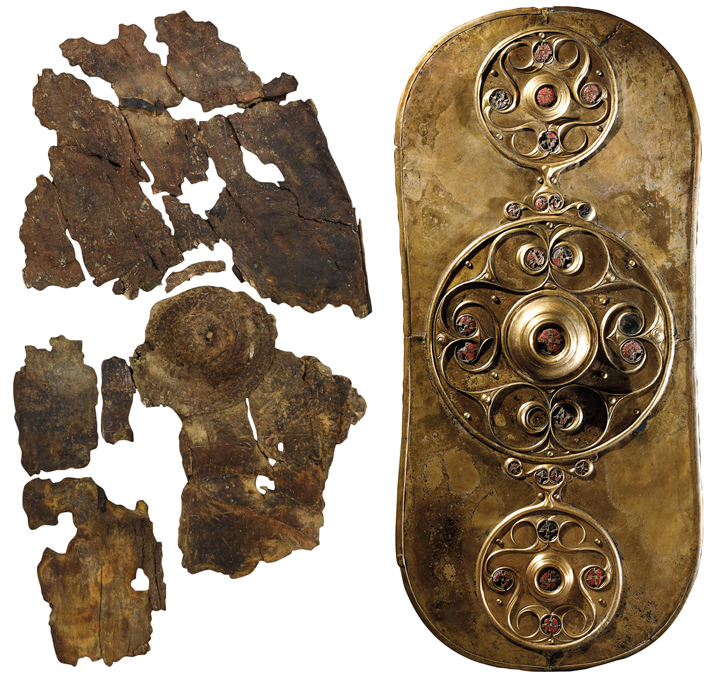 Given its life-saving potential, a shield might be a warrior’s most important resource. Although spectacular metal examples such as the Battersea Shield are well known, it’s the rare survival of shields fashioned from perishable materials that has produced a new understanding of the construction of these protective devices in Iron Age and Viking Age Europe. During a recent excavation near Enderby in central England, archaeologists discovered an Iron Age (ca. 750–43 B.C.) shield made of bark—the only such shield ever found in Europe. “The Enderby shield is a missing part in a whole sphere of organic shields, which must have once been abundant,” says archaeologist Matthew Beamish of University of Leicester Archaeological Services (ULAS). Some scholars have thought that the design of bark or wooden shields was based on metal examples, but the ULAS team suggests that the slight hourglass shape of Iron Age metal shields may instead have been modeled on the distinctive look produced by the drying process of bark or wood. Such bark or wooden shields were likely suited to light combat, where the relative weightlessness of the organic material offered a greater advantage than did the impregnability of a metal shield, explains Beamish.
Given its life-saving potential, a shield might be a warrior’s most important resource. Although spectacular metal examples such as the Battersea Shield are well known, it’s the rare survival of shields fashioned from perishable materials that has produced a new understanding of the construction of these protective devices in Iron Age and Viking Age Europe. During a recent excavation near Enderby in central England, archaeologists discovered an Iron Age (ca. 750–43 B.C.) shield made of bark—the only such shield ever found in Europe. “The Enderby shield is a missing part in a whole sphere of organic shields, which must have once been abundant,” says archaeologist Matthew Beamish of University of Leicester Archaeological Services (ULAS). Some scholars have thought that the design of bark or wooden shields was based on metal examples, but the ULAS team suggests that the slight hourglass shape of Iron Age metal shields may instead have been modeled on the distinctive look produced by the drying process of bark or wood. Such bark or wooden shields were likely suited to light combat, where the relative weightlessness of the organic material offered a greater advantage than did the impregnability of a metal shield, explains Beamish.
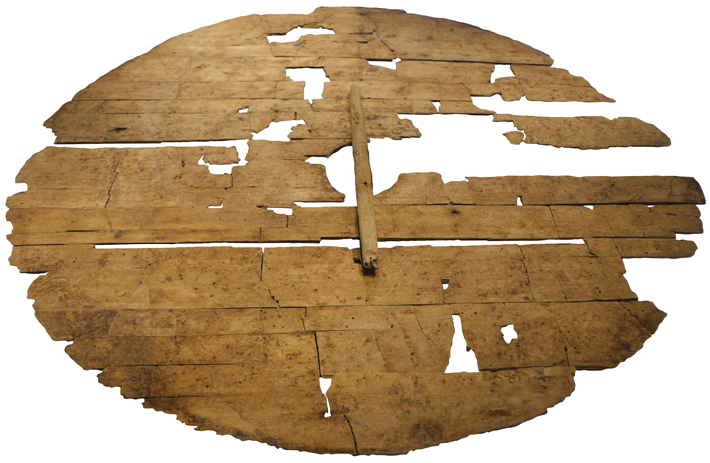 The impact of materials technology on the style of combat is also at the center of archaeologist Rolf Fabricius Warming’s recent investigation of shields made of animal hide. “Although it rarely survives in the archaeological record, hide has long been recognized as an essential component of shield construction used to reinforce extremely thin, easily splintered wooden shield boards,” says Warming, who is the founder of the Society for Combat Archaeology. Until now it hasn’t been possible to determine which animals the hides came from. Microanalysis of four Iron Age and Viking Age shields revealed that the hides employed were largely bovine skins, and that both deliberately tanned leather and rawhide were used, depending on what type of shield was required. “Hide was like the plastic of the age and could be processed into various products with different physical properties and levels of durability,” says Warming. “This dictated, or at least greatly influenced, the nature of combat and the fighting tactics of a shield’s carrier.”
The impact of materials technology on the style of combat is also at the center of archaeologist Rolf Fabricius Warming’s recent investigation of shields made of animal hide. “Although it rarely survives in the archaeological record, hide has long been recognized as an essential component of shield construction used to reinforce extremely thin, easily splintered wooden shield boards,” says Warming, who is the founder of the Society for Combat Archaeology. Until now it hasn’t been possible to determine which animals the hides came from. Microanalysis of four Iron Age and Viking Age shields revealed that the hides employed were largely bovine skins, and that both deliberately tanned leather and rawhide were used, depending on what type of shield was required. “Hide was like the plastic of the age and could be processed into various products with different physical properties and levels of durability,” says Warming. “This dictated, or at least greatly influenced, the nature of combat and the fighting tactics of a shield’s carrier.”
Fire Lances and Cannons
By ERIC A. POWELL
Friday, April 10, 2020
 In the ruins of Xanadu, the summer capital of the Mongol emperor Kublai Khan (r. A.D. 1260–1294), Chinese archaeologists unearthed one of the world’s earliest surviving guns. Measuring just 14 inches long, the bronze hand cannon was stamped with a serial number and a date corresponding to A.D. 1298. The small cannon was fashioned by Chinese artisans who benefited from working in a tradition of gunpowder weaponry that was already at least 400 years old. Some time just before the rise of China’s Song Dynasty (A.D. 960–1279), alchemists in search of new medicines found that, by combining nitrates such as saltpeter with sulfur and charcoal, they could create a chemical explosive. The Chinese word for gunpowder means “fire medicine,” but Song Dynasty officials were soon using the compound to construct simple explosives such as fire arrows and, in time, bombs. “People often think Europeans were the first to understand the military implications of gunpowder,” says Emory University historian Tonio Andrade. “But the Chinese understood gunpowder’s potential very early on.” By A.D. 1150, Song soldiers were using bamboo and wood proto-guns known as fire lances that were essentially flamethrowers.
In the ruins of Xanadu, the summer capital of the Mongol emperor Kublai Khan (r. A.D. 1260–1294), Chinese archaeologists unearthed one of the world’s earliest surviving guns. Measuring just 14 inches long, the bronze hand cannon was stamped with a serial number and a date corresponding to A.D. 1298. The small cannon was fashioned by Chinese artisans who benefited from working in a tradition of gunpowder weaponry that was already at least 400 years old. Some time just before the rise of China’s Song Dynasty (A.D. 960–1279), alchemists in search of new medicines found that, by combining nitrates such as saltpeter with sulfur and charcoal, they could create a chemical explosive. The Chinese word for gunpowder means “fire medicine,” but Song Dynasty officials were soon using the compound to construct simple explosives such as fire arrows and, in time, bombs. “People often think Europeans were the first to understand the military implications of gunpowder,” says Emory University historian Tonio Andrade. “But the Chinese understood gunpowder’s potential very early on.” By A.D. 1150, Song soldiers were using bamboo and wood proto-guns known as fire lances that were essentially flamethrowers.
 Historians have long regarded the Song Dynasty as militarily weak because the nomadic Liao, Jin, and Western Xia Dynasties encroached on its territory before it finally fell to the Mongols in A.D. 1279. Andrade points out that, in this turbulent period, these confrontations likely spurred rapid innovations in gunpowder warfare, leading to the creation of weapons that might be recognized today as guns. “What a gun looked like then is blurry by our standards,” he says. “Even the Xanadu gun may have been more like a fire lance than what we think of as a gun.”
Historians have long regarded the Song Dynasty as militarily weak because the nomadic Liao, Jin, and Western Xia Dynasties encroached on its territory before it finally fell to the Mongols in A.D. 1279. Andrade points out that, in this turbulent period, these confrontations likely spurred rapid innovations in gunpowder warfare, leading to the creation of weapons that might be recognized today as guns. “What a gun looked like then is blurry by our standards,” he says. “Even the Xanadu gun may have been more like a fire lance than what we think of as a gun.”
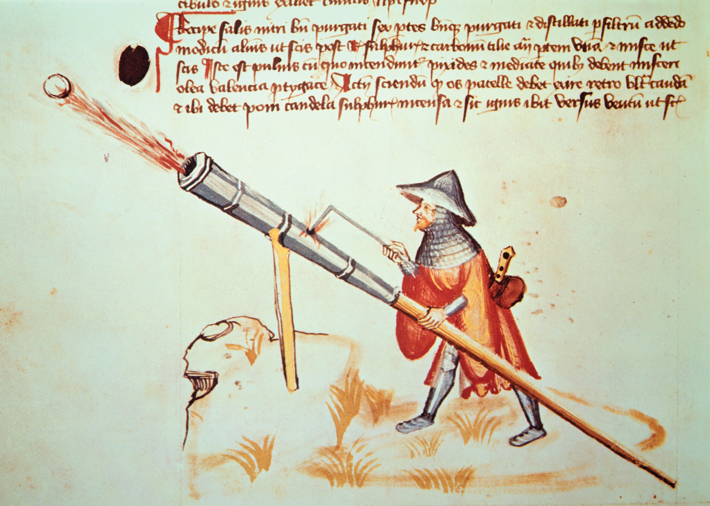 Two early metal cannons that seem to have functioned as guns have been unearthed in China’s northwestern Gansu Province, the domain of the Western Xia (A.D. 1038–1227). They bear no inscriptions, but based on the area where they were excavated, they may date to the early thirteenth century A.D. One cannon was even discovered with an iron ball and a measure of gunpowder still in its barrel. By A.D. 1227, the Mongols overwhelmed the Western Xia and went on to embrace gunpowder warfare. Guns spread throughout Asia in the wake of the Mongol conquests, reaching Europe by A.D. 1326. That year, the first known European illustration of a cannon appeared in a Latin treatise on the proper behavior of kings.
Two early metal cannons that seem to have functioned as guns have been unearthed in China’s northwestern Gansu Province, the domain of the Western Xia (A.D. 1038–1227). They bear no inscriptions, but based on the area where they were excavated, they may date to the early thirteenth century A.D. One cannon was even discovered with an iron ball and a measure of gunpowder still in its barrel. By A.D. 1227, the Mongols overwhelmed the Western Xia and went on to embrace gunpowder warfare. Guns spread throughout Asia in the wake of the Mongol conquests, reaching Europe by A.D. 1326. That year, the first known European illustration of a cannon appeared in a Latin treatise on the proper behavior of kings.
Siege Weapons
By BENJAMIN LEONARD
Friday, April 10, 2020
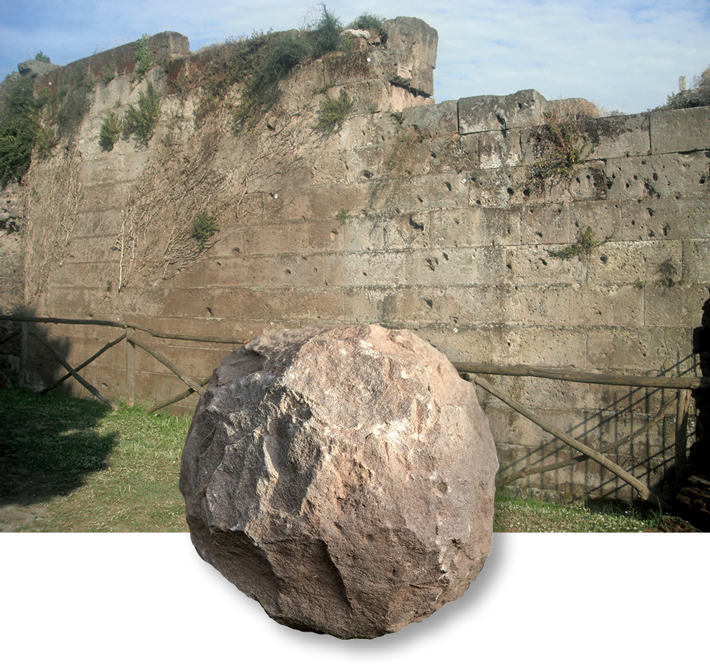 Some time around 89 B.C.—the exact year is debated—Roman forces led by the general Lucius Cornelius Sulla laid siege to the city of Pompeii, likely in response to its residents’ agitation for full Roman citizenship. The walls on the city’s north side, where fortifications were particularly weak, still bear the impact marks of projectiles fired by the attacking Romans. In a number of areas inside the city walls, archaeologists have found catapult balls, small lead slingshot bullets, and machine-launched arrows known as scorpio bolts, all fired during the siege. “I don’t think anyone at the time was under any illusions that sustained bombardment would actually bring down the walls,” says archaeologist Ivo Van der Graaff of the University of New Hampshire. “It looks like one of the Romans’ tactics was to just fire munitions into the city to cause damage and, perhaps, lower morale.”
Some time around 89 B.C.—the exact year is debated—Roman forces led by the general Lucius Cornelius Sulla laid siege to the city of Pompeii, likely in response to its residents’ agitation for full Roman citizenship. The walls on the city’s north side, where fortifications were particularly weak, still bear the impact marks of projectiles fired by the attacking Romans. In a number of areas inside the city walls, archaeologists have found catapult balls, small lead slingshot bullets, and machine-launched arrows known as scorpio bolts, all fired during the siege. “I don’t think anyone at the time was under any illusions that sustained bombardment would actually bring down the walls,” says archaeologist Ivo Van der Graaff of the University of New Hampshire. “It looks like one of the Romans’ tactics was to just fire munitions into the city to cause damage and, perhaps, lower morale.”
By the Middle Ages, engineers had perfected projectile-launching machines that could wreak havoc on even the most robust fortifications. During recent excavations at Hay Castle in southeast Wales, archaeologists unearthed a thirteenth-century stone ball catapulted from a siege machine called a trebuchet. The 63-pound stone is roughly the same size and weight as catapult balls excavated at other Welsh castles. “Only multiple impacts in the same place would demolish a wall,” says archaeologist Chris Caple of Durham University. “Trebuchet balls were deliberately created to be the same weight and size so they would all land in the same spot when fired.” Although researchers haven’t yet found other archaeological evidence of a siege at Hay Castle, documents record multiple fires and attacks during the thirteenth century, including one in July 1265, when the nobleman Simon de Montfort, King Henry III’s leading opponent, took the castle with the aid of allied Welsh princes.
Bashers
By MARLEY BROWN
Friday, April 10, 2020
 The use of a blunt object to strike an opponent may be the simplest—and the oldest—method of armed combat. Two artifacts separated by an ocean and more than five millennia, however, illustrate that items appearing to have this particular function may actually have been designed and used for multiple purposes. The first, a club known as the Thames Beater, was discovered in the mud on the banks of England’s Thames River and dates to around 3500 B.C. The beater was likely a utilitarian object employed in a variety of daily activities, as well as for self-protection. “Single-function weapons of violence are largely absent in the Neolithic period in Western Europe,” says archaeologist Linda Fibiger of the University of Edinburgh. “We tend to think of them as weapon-tools that probably had multiple functions, which could include use as a weapon.”
The use of a blunt object to strike an opponent may be the simplest—and the oldest—method of armed combat. Two artifacts separated by an ocean and more than five millennia, however, illustrate that items appearing to have this particular function may actually have been designed and used for multiple purposes. The first, a club known as the Thames Beater, was discovered in the mud on the banks of England’s Thames River and dates to around 3500 B.C. The beater was likely a utilitarian object employed in a variety of daily activities, as well as for self-protection. “Single-function weapons of violence are largely absent in the Neolithic period in Western Europe,” says archaeologist Linda Fibiger of the University of Edinburgh. “We tend to think of them as weapon-tools that probably had multiple functions, which could include use as a weapon.”

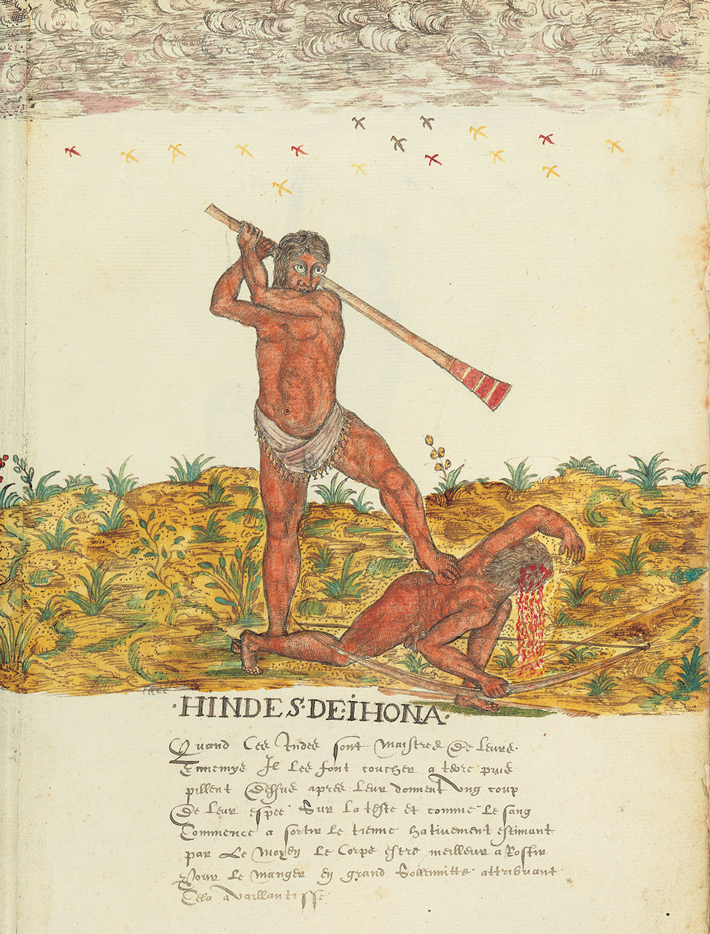 The second artifact, an ornately carved war club, was originally recovered in the 1970s from the wreck of the Spanish ship San Pedro, which sank off the coast of Bermuda in 1596. It may have been used in combat only sparingly, if at all. This type of club, which rarely survives, was wielded by Carib-speaking people from the region surrounding the mouth of the Orinoco River in Venezuela and on the Caribbean islands to the north. Some examples were collected as curios by early colonial explorers. “These clubs were formidable weapons made of heavy, durable wood, though their considerable length would have made them somewhat unwieldy, unless you were a certain distance from your opponent,” says archaeologist Joanna Ostapkowicz of the University of Oxford. “I would think this style of weapon became more linked with status—the longer and more impressive your club, the higher your standing in the community.”
The second artifact, an ornately carved war club, was originally recovered in the 1970s from the wreck of the Spanish ship San Pedro, which sank off the coast of Bermuda in 1596. It may have been used in combat only sparingly, if at all. This type of club, which rarely survives, was wielded by Carib-speaking people from the region surrounding the mouth of the Orinoco River in Venezuela and on the Caribbean islands to the north. Some examples were collected as curios by early colonial explorers. “These clubs were formidable weapons made of heavy, durable wood, though their considerable length would have made them somewhat unwieldy, unless you were a certain distance from your opponent,” says archaeologist Joanna Ostapkowicz of the University of Oxford. “I would think this style of weapon became more linked with status—the longer and more impressive your club, the higher your standing in the community.”
Advertisement
Advertisement
IN THIS ISSUE
Advertisement

Recent Issues
-
 May/June 2024
May/June 2024
-
 March/April 2024
March/April 2024
-
 January/February 2024
January/February 2024
-
 November/December 2023
November/December 2023
-
 September/October 2023
September/October 2023
-
 July/August 2023
July/August 2023
-
 May/June 2023
May/June 2023
-
 March/April 2023
March/April 2023
-
 January/February 2023
January/February 2023
-
 November/December 2022
November/December 2022
-
 September/October 2022
September/October 2022
-
 July/August 2022
July/August 2022
-
 May/June 2022
May/June 2022
-
 March/April 2022
March/April 2022
-
 January/February 2022
January/February 2022
-
 November/December 2021
November/December 2021
-
 September/October 2021
September/October 2021
-
 July/August 2021
July/August 2021
-
 May/June 2021
May/June 2021
-
 March/April 2021
March/April 2021
-
 January/February 2021
January/February 2021
-
 November/December 2020
November/December 2020
-
 September/October 2020
September/October 2020
-
 July/August 2020
July/August 2020
-
 May/June 2020
May/June 2020
-
 March/April 2020
March/April 2020
-
 January/February 2020
January/February 2020
-
 November/December 2019
November/December 2019
-
 September/October 2019
September/October 2019
-
 July/August 2019
July/August 2019
-
 May/June 2019
May/June 2019
-
 March/April 2019
March/April 2019
-
 January/February 2019
January/February 2019
-
 November/December 2018
November/December 2018
-
 September/October 2018
September/October 2018
-
 July/August 2018
July/August 2018
-
 May/June 2018
May/June 2018
-
 March/April 2018
March/April 2018
-
 January/February 2018
January/February 2018
-
 November/December 2017
November/December 2017
-
 September/October 2017
September/October 2017
-
 July/August 2017
July/August 2017
-
 May/June 2017
May/June 2017
-
 March/April 2017
March/April 2017
-
 January/February 2017
January/February 2017
-
 November/December 2016
November/December 2016
-
 September/October 2016
September/October 2016
-
 July/August 2016
July/August 2016
-
 May/June 2016
May/June 2016
-
 March/April 2016
March/April 2016
-
 January/February 2016
January/February 2016
-
 November/December 2015
November/December 2015
-
 September/October 2015
September/October 2015
-
 July/August 2015
July/August 2015
-
 May/June 2015
May/June 2015
-
 March/April 2015
March/April 2015
-
 January/February 2015
January/February 2015
-
 November/December 2014
November/December 2014
-
 September/October 2014
September/October 2014
-
 July/August 2014
July/August 2014
-
 May/June 2014
May/June 2014
-
 March/April 2014
March/April 2014
-
 January/February 2014
January/February 2014
-
 November/December 2013
November/December 2013
-
 September/October 2013
September/October 2013
-
 July/August 2013
July/August 2013
-
 May/June 2013
May/June 2013
-
 March/April 2013
March/April 2013
-
 January/February 2013
January/February 2013
-
 November/December 2012
November/December 2012
-
 September/October 2012
September/October 2012
-
 July/August 2012
July/August 2012
-
 May/June 2012
May/June 2012
-
 March/April 2012
March/April 2012
-
 January/February 2012
January/February 2012
-
 November/December 2011
November/December 2011
-
 September/October 2011
September/October 2011
-
 July/August 2011
July/August 2011
-
 May/June 2011
May/June 2011
-
 March/April 2011
March/April 2011
-
 January/February 2011
January/February 2011
Advertisement






